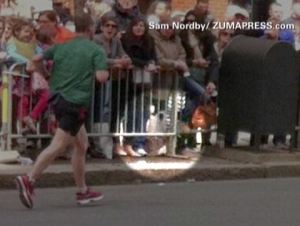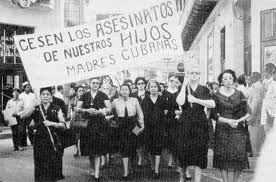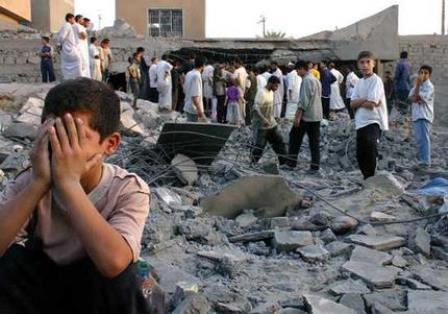“If you see something, say something. If you see a suspicious package or activity on an MTA train or platform, do not keep it to yourself, alert the nearest MTA employee or police officer.”
For many people on the subway, the conductor’s announcement falls on deaf ears, like falling rain. But I listen to it. I get it.
As I viewed the photographs of the horrific bombing scenes in Boston, my attention was drawn to those pictures taken before the explosions which showed that the unattended backpacks apparently drew no suspicions from people standing in very close proximity to them. No doubt those people were distracted by the passing runners. But it may also be that Americans, for the most part, and perhaps less so New Yorkers, are not attuned psychically to the possibility of terrorism, that is, they do not instinctively assume, for example, that the unattended package they have suddenly encountered poses a real danger.
standing in very close proximity to them. No doubt those people were distracted by the passing runners. But it may also be that Americans, for the most part, and perhaps less so New Yorkers, are not attuned psychically to the possibility of terrorism, that is, they do not instinctively assume, for example, that the unattended package they have suddenly encountered poses a real danger.
My reaction is different: I react immediately with suspicion to packages I see in public places. It was wired into my brain circuitry in the Havana of my childhood when an illegal and decrepit government clung to power and a revolutionary urban underground movement sought to depose it through violence in the streets. That Havana of the 1950s, where a Cuban boy could have his grade school class interrupted by the sound of gunfire, where photographs of bloodied dead bodies on both sides of the conflict showed up almost daily in the morning papers, where the presidential palace was
when an illegal and decrepit government clung to power and a revolutionary urban underground movement sought to depose it through violence in the streets. That Havana of the 1950s, where a Cuban boy could have his grade school class interrupted by the sound of gunfire, where photographs of bloodied dead bodies on both sides of the conflict showed up almost daily in the morning papers, where the presidential palace was  militarily assaulted and dozens were killed, where the sound of distant gunfire broke the stillness of the night, where military trucks rumbled through residential neighborhoods, where people jumped at the sound of an engine backfire or of a ceremonial cannon fired from a historic fortress.
militarily assaulted and dozens were killed, where the sound of distant gunfire broke the stillness of the night, where military trucks rumbled through residential neighborhoods, where people jumped at the sound of an engine backfire or of a ceremonial cannon fired from a historic fortress.
And it was a place and time where you learned to heed your parents’ admonition, repeated incessantly, like the MTA message, to stay alert and the hell away from any packages you might see on the street. One never forgets that, even after more than half a century. I love fireworks but not their sounds. I assume the worst when I hear firecrackers. And to this day, a lonely package in a public place can give me cause to pause. Only four days before the Boston bombings, I froze when I walked into my class and spied a small shopping
and the hell away from any packages you might see on the street. One never forgets that, even after more than half a century. I love fireworks but not their sounds. I assume the worst when I hear firecrackers. And to this day, a lonely package in a public place can give me cause to pause. Only four days before the Boston bombings, I froze when I walked into my class and spied a small shopping  bag that had been left in a corner of the classroom. Fortunately, it was open, so I forced myself to walk slowly towards it and peer in, without touching it. It was the detritus of someone’s breakfast.
bag that had been left in a corner of the classroom. Fortunately, it was open, so I forced myself to walk slowly towards it and peer in, without touching it. It was the detritus of someone’s breakfast.
I suspect I share this sensitivity (phobia, if you like), with many of my Cuban contemporaries. And I know share it with many people around the world who grew up in places and times in which bombings and shootings were part of their daily lives. The street violence of pre-revolutionary Havana, after all, was nothing compared with what many children have experienced, and continue to experience, in the Middle East and other regions with protracted and devastating conflicts.
That is not normal. It is not the way children should grow up. And that is not the way that children have grown up in the United States, a country that, despite 9/11, has not had to habituate itself to random acts of terrorism directed at innocent persons in public places; it has not had to internalize a hyper sensitivity to dangers in the streets.
What is normal is that in a crowd watching a marathon no one should have to worry about a stray package. But what is normal may be changing in this country. Let’s hope not. By far most of my childhood memories in Cuba are truly pleasant. I could, of course, do without those that are not.


I lived through those same years In Cuba during my childhood and early adolescence, and share your phobia. It is sad that our children and grandchildren will have to experience the same fears in the United States.
I have heard alot of what you said in this post from my parents who were both born in Cuba. I’m so glad you posted again…there was a bit of a wait since your last post, but worth the wait. Thank you!
The widespread terrorism carried out by the 26th of July Movement in Cuba during the 1950s did differ in one important respect from that perpetrated in recent years by Al Queda and its affiliates in the U.S.: radical Muslims regard Americans as the “enemy” and justify their attacks upon them as “acts of war.” The 26th of July Movement also targetted public places and civilians, though, ostensibly these were the people that they wanted to “liberate.” The Cuban Revolution was not so much a guerrila war as a terrorist conflict which employed Weyler’s tactic of targetting non-combatents and spreading death outside the parameters of the battlefield (which both sides did their best to avoid at all times).
Uva:
You had more reason to fear the July 26th Movement’s bombs than most Cuban children did, since your stepfather, Carlos Márquez-Sterling, was targetted for assassination by the so-called “urban resistance” because he did not boycott the 1958 presidential election. The brother of the government candidate, Andrés Rivero Aguero, was assassinated in his own home, in front of his children, by Castro’s goons. Yes, you were very lucky.
Thanks for this post, I apologize for my late reply again. It should be noted that the 26th of July movement was only part of the underground movement then, there were other groups like the DRE that have been forgotten. A short story on this, I visited the small town of Cardenas, just outside Matanzas about 5 ears ago.
It is the hometown of Jose Antonio Echeverria, who was the leader of the failed assassination attempt on Batista’s presidential palace in 1957 that is referred to in the blog post. The local museum has a bust of Echeverria, and my friend asked the museum guide who he was. She had no idea, so I jumped in and explained. She left us briefly and after a conversation with one of the older staff, returned and confirmed my story.
I was shocked that a museum guide had no idea who Jose Antonio Echeverria was.in his hometown. When I asked her how old she was, she said 20. But still…